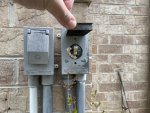- Jun 8, 2019
- 4,581
- Pool Size
- 20000
- Surface
- Vinyl
- Chlorine
- Salt Water Generator
- SWG Type
- Pentair Intellichlor IC-60
Here’s our main panels, the pool sub-panels (all in a small room in the basement), a shot of our pump, and a shot of the switch it goes into.That should work. The CL600 model is a little bit less expensive and should be ok.
It might be easiest to access the wires for a voltage or current test at the switch.
Do you have a picture of the switch or timer that provides power to the pump?
Until the VS pump and its programmable timer built-in, we just used this switch to turn the VS pump on and off.















